Partway through Beethoven’s 7th Symphony, the
music swells from the alpine French Horn theme to full orchestral voice. The string section’s bows reach to full sweep
and the musicians lean in towards their music, brows furrowed in
concentration.
The marble columns of the antique courtyard swell with the
power of the small orchestra, the arcade’s romanesque vaults grow taller and the
marble angel over the palace entrance appears to turn his head and smile.
The small audience holds its collective breath as the music
reaches forte fortissimo, many closing their eyes as the rich tones of cellos and
basses, bassoons and kettle drums envelop them.
And it ends. There is
silence. The audience exhales and erupts
in applause. And the small stone
courtyard glows with happiness.
On our last night in Croatia, we attend a concert of the
Dubrovnik Symphony Orchestra, held in the open courtyard of the 16th century
Rector’s Palace. It’s an evening that
encapsulates so much of what we have learned about the country in the past few
days.
Dubrovnik was founded as a Roman outpost on an island secure
from the marauding Slavs. An independent
City State for much of its history, it evolved into a sea power that rivaled
Venice. The current solid stone
uniformity – an almost Disneyesque
perfection – resulted from organized rebuilding after the earthquake of 1667. It wasn’t conquered until 1808 when its
citizens turned the town over to Napoleon as he confronted the Ottoman Turks,
rather than see their beloved home become a battleground.

But the long history of the “The Pearl of the Adriatic” has a much more recent and tragic chapter. The city walls were needed to defend the city when Croatia declared its independence in 1991 and the Yugoslav Army laid siege. Rather than relinquish control, a rag tag militia was raised and the city defended – but at great cost. Hundreds died and historic buildings and artworks were destroyed in bombardment from nearby highlands.

Today, museums explain the confrontation with a strong Croat
slant, but the most impressive memorial is the magnificent reconstruction of
the inner city.
 Today the still solid walls encompass the polished stones of
the Stradun – the broad main avenue that starts at the huge Onofrijeva fountain (bringing
a secure source of fresh water from the hills above) and links the Franciscan
and Dominican Monasteries (which catered to the poor and the wealthy
respectively) before turning right at the city hall and bell tower, passing the
Rector’s Palace (the elected city ruler) and ending at the cathedral.
Today the still solid walls encompass the polished stones of
the Stradun – the broad main avenue that starts at the huge Onofrijeva fountain (bringing
a secure source of fresh water from the hills above) and links the Franciscan
and Dominican Monasteries (which catered to the poor and the wealthy
respectively) before turning right at the city hall and bell tower, passing the
Rector’s Palace (the elected city ruler) and ending at the cathedral.
On the seaward side, stone lanes are lined with handsome
buildings housing smart apartments, sidewalk restaurants and fancy shops
catering to hoards of cruise ship tourists.
On the landward side, steep, shoulder-width stairs are lined with a hodgepodge of everyday dwellings – windows and doors open to catch the occasional sea breeze, laundry hanging where it can over head, children’s shouts echoing from unseen play.
On the landward side, steep, shoulder-width stairs are lined with a hodgepodge of everyday dwellings – windows and doors open to catch the occasional sea breeze, laundry hanging where it can over head, children’s shouts echoing from unseen play.
The unifying attraction is the hour-long stroll around Dubrovnik’s unbroken walls - an opportunity to study the city’s maze of rooftop and lanes, spot landmarks, gaze out over the robust multi-tones of the Adriatic and up at the sheer, barren slopes of Mt. Srd. We did it late in the day when the glow of the descending sun bathed the buildings in a golden light and cooling sea breezes lifted our tired spirits.
The Dubrovnik Symphony Orchestra’s tour-de-force was the perfect end-point of our visit to Croatia: European to the core, dripping in culture and power; echoing tones on a long memory and the heaviness of recent wars tempered with resilience, civic pride and future dreams; played in an ancient venue encapsulating what many call Europe’s most beautiful city.
-
30 -


















